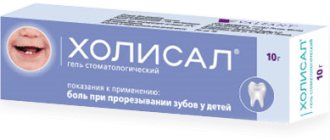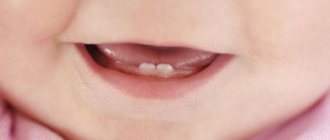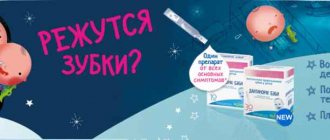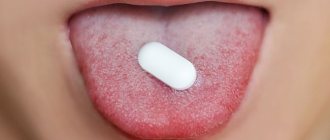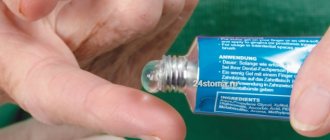Description of the drug
Kalgel is available only in the form of a dental gel. The drug has a uniform thick consistency, without inclusions, dark yellow color and a specific odor.
1 g of gel contains 3.3 mg of lidocaine hydrochloride and 1 mg of cetylpyridinium chloride. Additionally, there is a solution of sorbitol, ethanol, glycerol, citric acid monohydrate, macrogol, xylitol, levomenthol, saccharinate and sodium citrate, flavorings and water.
The gel is packaged in 10 g aluminum tubes. Sold in cardboard boxes complete with instructions. Produced in Poland.
Rules for storing Kalgel in pharmacies and clinics
In pharmacies and clinics, Kalgel should be stored in special refrigerators designed for storing this type of medicine. Here they are kept both for treatment and for sale.
Disposal is provided when a spoiled or expired medication is identified. According to the standards prescribed in GOST 17768-90, only employees of companies that have official permission from the city or local administration, and also if they have the necessary equipment, can destroy medical supplies.
Transportation is also carried out in accordance with GOST - in vehicles equipped with special refrigerators.
Therapeutic effects of Kalgel
According to the instructions, Kalgel is a combination product that has an antimicrobial effect on the oral mucosa and also has a local analgesic effect.
The mechanism of action is determined by the properties of the main active substances included in it.
Lidocaine hydrochloride inhibits nerve conduction by blocking sodium channels, and therefore has a local anesthetic effect.
Cetylpyridinium chloride belongs to the group of antiseptics that suppress the proliferation of pathogenic microflora in the oral cavity.
Kalgel
Kalgel (lidocaine + cetylpyridinium chloride) is a drug for local anesthesia in dentistry. To realize its anesthetic effect, it is applied to the oral mucosa. Lidocaine is a local anesthetic. It is quickly absorbed from the site of application and enters the blood, where it interacts with plasma proteins. Rapidly undergoes metabolic transformations in the liver. Excreted along with urine. Cetylpyridinium chloride is a disinfectant. It is absorbed to a small extent in the oral mucosa. Kalgel is used to quickly eliminate pain during teething and prevent irritation (hyperemia, swelling) of the gums. It is used in pediatric practice after the child reaches three months of age. A single dose is about 7.5 mm of gel. Application and subsequent rubbing of the drug into the inflamed gums is done with the tip of your finger (before squeezing the required amount of gel onto your finger, you must wash your hands thoroughly). Repeated application is possible after 20 minutes, and the frequency of use of Kalgel should not exceed 6 times a day. If you strictly follow the instructions, the risk of developing any unwanted side reactions is minimal. In rare cases, after local injections, episodes of hypersensitivity to one of the active components of the drug, lidocaine, were recorded.
Manifestations of hypersensitivity - skin rashes, local swelling, slight difficulty breathing. Kalgel's herbal flavor contains chamomile, which can cause allergies in people predisposed to atopy. Cases of allergic reactions due to the consumption of herbal teas, which included chamomile, have been documented. If adverse reactions develop, you should stop using the drug and seek medical advice. Kalgel contains fructose, so the drug is contraindicated in persons with genetically determined fructose intolerance. The drug is contraindicated during pregnancy and breastfeeding (its effect in this category of patients has not been studied). If the recommended doses or frequency of use of Kalgel is exceeded, a decrease in the sensitivity of taste and temperature receptors located in the pharynx and oral cavity may develop. A similar case was described in a man who, while gargling, accidentally swallowed approximately 100 mg of lidocaine, which is equivalent to 5.5 g of Calgel gel. It should be noted that even if the recommended doses are significantly exceeded, the likelihood that toxic concentrations of lidocaine or cetylpyridinium chloride will be achieved is extremely low. The pharmacological interaction of Kalgel with other drugs has not been studied.
Contraindications for using Kalgel
The gel is not prescribed for hypersensitivity to lidocaine or cetylpyridinium chloride, as well as to other components of the drug.
Also contraindicated are:
- low blood pressure (pressure not higher than 100/60 mm Hg);
- serious impairment of all liver or kidney functions;
- heart failure syndrome grade 2-3;
- arrhythmia, which is characterized by a decrease in heart rate to 60 beats per minute and below;
- cardiac pathology associated with slowing or blocking the passage of impulses through the ventricles.
How to store Kalgel at home
After purchase, Kalgel should be stored out of the reach of children at a temperature not exceeding +25 °C.
It is best to store the drug in a place where there are no sudden changes in temperature and high humidity.
The medicine should be stored in its original container , since when moved to another container, it may dry out and be unsuitable for use.
Also, do not store medications in the bathroom or kitchen, where there is such a risk. For this dosage form, there is no fundamental difference whether the drug is stored at room temperature or in the refrigerator. Both options are acceptable. However, you should not place Kalgel close to the freezer, otherwise the medication may freeze.
Analogues:
- Kamistad
- Dentinox
- Dentol baby
Reviews
On the Internet you can find polar opinions from experts about Kalgel. Some pediatricians consider the gel unsafe due to the presence of lidocaine. The effect is short-lived, since the drug is washed off with saliva. The other part speaks extremely positively about the gel, emphasizing its effectiveness, pleasant taste and ease of use, including for stomatitis in children. After application there is no unpleasant sensation in the form of burning or tingling, the analgesic effect occurs quite quickly.
Parents also have mixed reviews of the gel. Most note that the drug helped with painful teething. Due to excessive salivation, the effect of use is short-lived. Not all parents like the fact that it is necessary to smear swollen gums with gel, the touch of which is painful. Among the disadvantages is the high price of the medicine.
A few final recommendations for parents:
Below we list some more tips for parents that will help you understand the behavior of a small child, for example, when he feels discomfort during teething.
1) The baby is constantly trying to chew something -
In this case, you can use a clean finger or special teething rings to massage the baby’s gums for 2 minutes (should be repeated several times a day). Finger massage calms most children, allowing them to relieve itching in the gums, but some children may protest against such a massage. Of course, it is best in this case to provide the child with special safe items for chewing (rubber teething rings). By the way, they can be additionally cooled, and then your baby will calm down even faster.
2) Refusal to eat –
Keep in mind that eating warm foods will aggravate teething symptoms, while eating cool, cool foods will provide relief for your baby.
3) If the skin around the mouth, chin is irritated -
You should regularly wipe the baby's skin around the mouth dry. If a rash or irritation occurs, you should treat the skin with a special baby cream that will contain various anti-inflammatory components.
4) If the baby rubs his cheek or ear -
In this case, the child is trying to say that he has some kind of pain or discomfort. And this does not mean at all that the child has ear inflammation, because... When teething, pain often radiates along nerve fibers to other areas. In this case, you should give the child a mild pain reliever, for example, Panadol and Nurofen. We hope that our article was useful to you!
Sources:
1. Dental education of the author of the article, 2. Based on personal experience as a dentist, 3. The European Academy of Pediatric Dentistry (EU), 4. National Library of Medicine (USA), 5. https://www.vidal. ru/, 6. “Pediatric therapeutic dentistry. National leadership" (Leontyev V.K.).
Side effects
Most often, after applying Kalgel, children experience allergic reactions in the form of urticaria, dermatitis and eczema. Quincke's edema is less common. The last symptom is a reason to call emergency help. Otherwise, the child may suffocate.
To avoid unpleasant symptoms from drug treatment, before using Kalgel for a child, parents should first consult with a pediatrician
Among the signs of a drug overdose, the following should be noted:
- difficulty breathing;
- bradycardia;
- pale skin;
- vomiting;
- nausea.
Customer Reviews
Pauline. A few months ago I encountered the problem of bleeding gums. Added to this problem was a wisdom tooth, which erupted very painfully. I read reviews on the Internet and decided to try Kalgel to combat my problem. After the first application, the pain disappeared within 30 minutes, which pleasantly surprised me. I used the gel 2 times a day until the wisdom tooth erupted completely. I was pleased with the results of using Kalgel. The only drawback of the drug is its cost (about 280 rubles per 10 mg tube).
Natalia. My daughter had a very hard time getting her first baby teeth out. For several nights she could not sleep normally, and during the day she refused to eat. The pharmacy recommended that I buy Kalgel. I used it 3 times a day and noticed an improvement in my daughter’s well-being. She gained an appetite and slept better. Together with Kalgel I gave my daughter Nurofen. So we survived a difficult time for us.
Larisa. Our child's teething did not always go smoothly. Once, my husband had to run in the middle of the night to get painkillers because his son couldn’t sleep. The drug cost us 300 rubles, but we did not regret buying it.
Properties
Kalgel is distinguished by its combined action. Thanks to this, it can have several effects on problem areas of the oral mucosa at once. The gel quickly relieves symptoms characteristic of dental disorders.
Effects provided by the gel:
- Analgesic. This is achieved thanks to the anesthetic contained in the product. It is worth noting that the analgesic effect of the medication does not last long.
- Antimicrobial. The product inhibits the proliferation of pathogenic flora in the mouth, thereby preventing the development of complications against the background of the inflammatory process.
- Anti-inflammatory. The drug relieves the feeling of itching and the intensity of inflammation a few minutes after applying the gel to the gums. The condition of the babies quickly improves after applying the product.
The effect of Kalgel lasts for 2–3 hours. After this, the child will again be capricious and scratch his gums.

